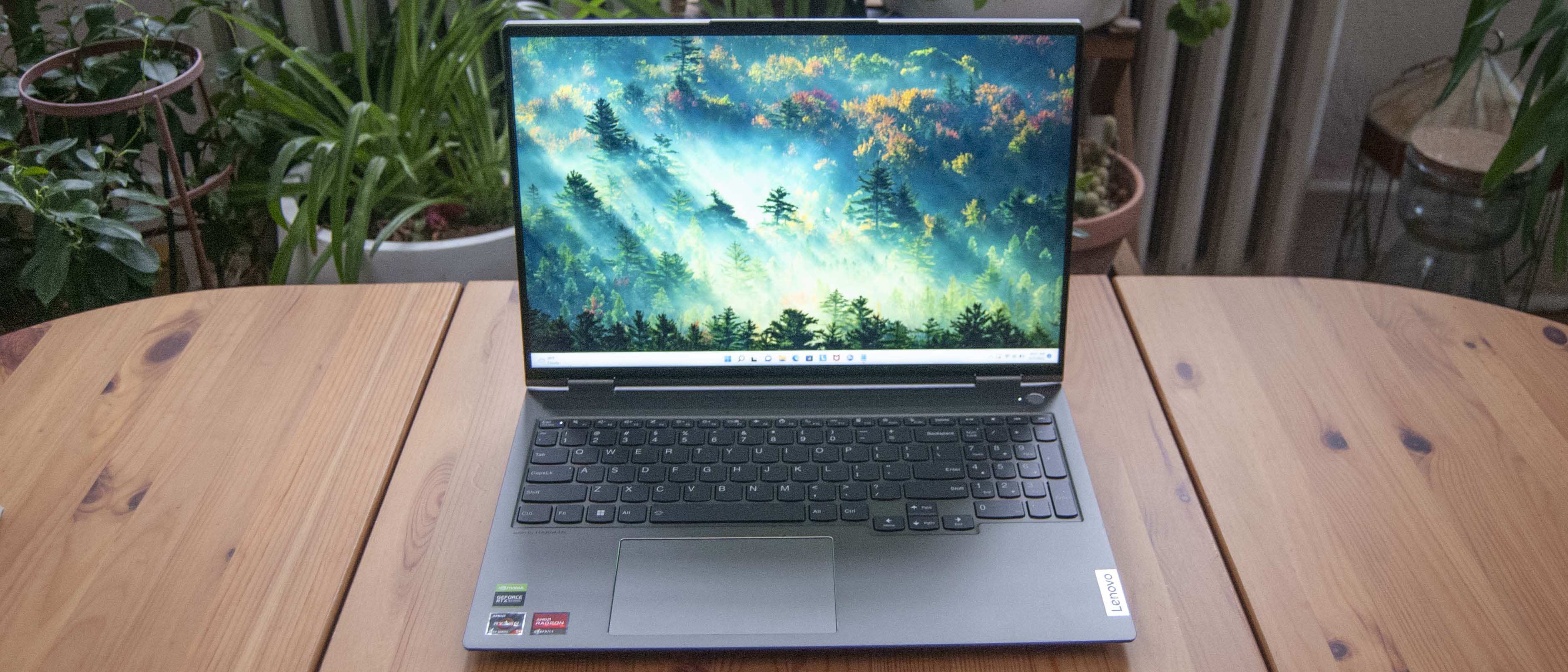Windows Central Verdict
Lenovo ThinkBook 16p (Gen 3) is a well-built creator laptop with the extra hardware needed to handle getting into specialized work. However, display color could be better and Ryzen performance is lacking next to Intel's 12th Gen chips. It's also not yet available in all regions, making it hard to compare prices. If you need a 16-inch creator laptop right now, there is plenty of competition available.
Pros
- +
Rear port setup helps with cable management
- +
Excellent keyboard
- +
High-res display with 165Hz refresh rate
- +
Decent battery life for the level of hardware
Cons
- -
Touchpad is off center and has a hollow click
- -
FHD camera is still a bit grainy
- -
Screen lacks accurate AdobeRGB and DCI-P3 color
- -
No Thunderbolt 4 (USB4 is still a decent substitute)
Why you can trust Windows Central
Lenovo's ThinkBook 16p (Gen 3) was announced earlier this year at IFA 2022, and like its predecessors it's meant to accommodate creators and designers who want some extra screen space and overhead performance for more demanding tasks. The new ThinkBook 16p is packing AMD's Ryzen 6000 H-series CPUs, up to a NVIDIA RTX 3060 Laptop GPU, and a gorgeous QHD+ display with 165Hz refresh rate and Dolby Vision. I've been using the laptop for the past week for all sort of task to see how well it performs, where its design excels, and, ultimately, whether or not it's worth your money.
Lenovo ThinkBook 16p (Gen 3): Price, availability, and specs
Lenovo supplied Windows Central with a review unit of its new ThinkBook 16p (Gen 3). This model is fairly high-end and includes an AMD Ryzen 9 6900HX processor (CPU), 32GB of LPDDR5-6400MHz RAM that's soldered and not upgradeable, a 1TB M.2 PCIe 4.0 NVMe SSD that is upgradeable, and a NVIDIA RTX 3060 Laptop GPU. My review unit also has the more expensive display with QHD+ resolution, HDR 400, and 165Hz refresh rate.
This laptop is still listed as "Coming Soon" in a bunch of regions, including USA and Canada. When it does officially launch in all regions, you should be able to find AMD Ryzen 5 6600H and Ryzen 7 6800H CPU options, as well as a more affordable QHD+ display with lower 60Hz refresh rate. When the laptop was announced, it was expected that prices would start at about $2,379 USD before any of Lenovo's frequent rebates.
Here's a look at the exact specifications that make up my review unit.
| Header Cell - Column 0 | Lenovo ThinkBook 16p (Gen 3) |
|---|---|
| OS | Windows 11 Home |
| Processor | AMD Ryzen 9 6900HX |
| Row 2 - Cell 0 | 8 cores, 16 threads |
| RAM | 32GB LPDDR5-6400MHz |
| Row 4 - Cell 0 | Dual-channel, soldered |
| Graphics | NVIDIA RTX 3060 |
| Row 6 - Cell 0 | NVIDIA Studio drivers |
| Storage | 1TB M.2 PCIe 4.0 NVMe SSD |
| Row 8 - Cell 0 | Two M.2 slots, upgradeable |
| Display | 16 inches, 16:10 aspect ratio, IPS, Dolby Vision |
| Row 10 - Cell 0 | 2560x1600 (2.5K), 165Hz, anti-glare, HDR400, X-Rite Pantone color calibration |
| Ports | USB4, USB-C 3.2 (Gen 2), two USB-A 3.2 (Gen 2), HDMI, SD card reader, 3.5mm audio |
| Audio | Dual 2W Harman speakers, Dolby Atmos, Smart AMP |
| Wireless | Wi-Fi 6, Bluetooth 5.1 |
| Camera | FHD + IR camera |
| Security | TPM 2.0, Kensington Nano lock slot, fingerprint reader, IR camera, webcam shutter |
| Battery | 71Wh |
| Dimensions | 14.02 x 9.92 x 0.64-0.78 inches |
| Row 18 - Cell 0 | (356mm x 252mm x 16.3-19.9mm) |
| Weight | From 4.39 pounds (1.99kg) |
| Color | Mineral grey |
| Material | Aluminum |
Lenovo ThinkBook 16p (Gen 3): What I like
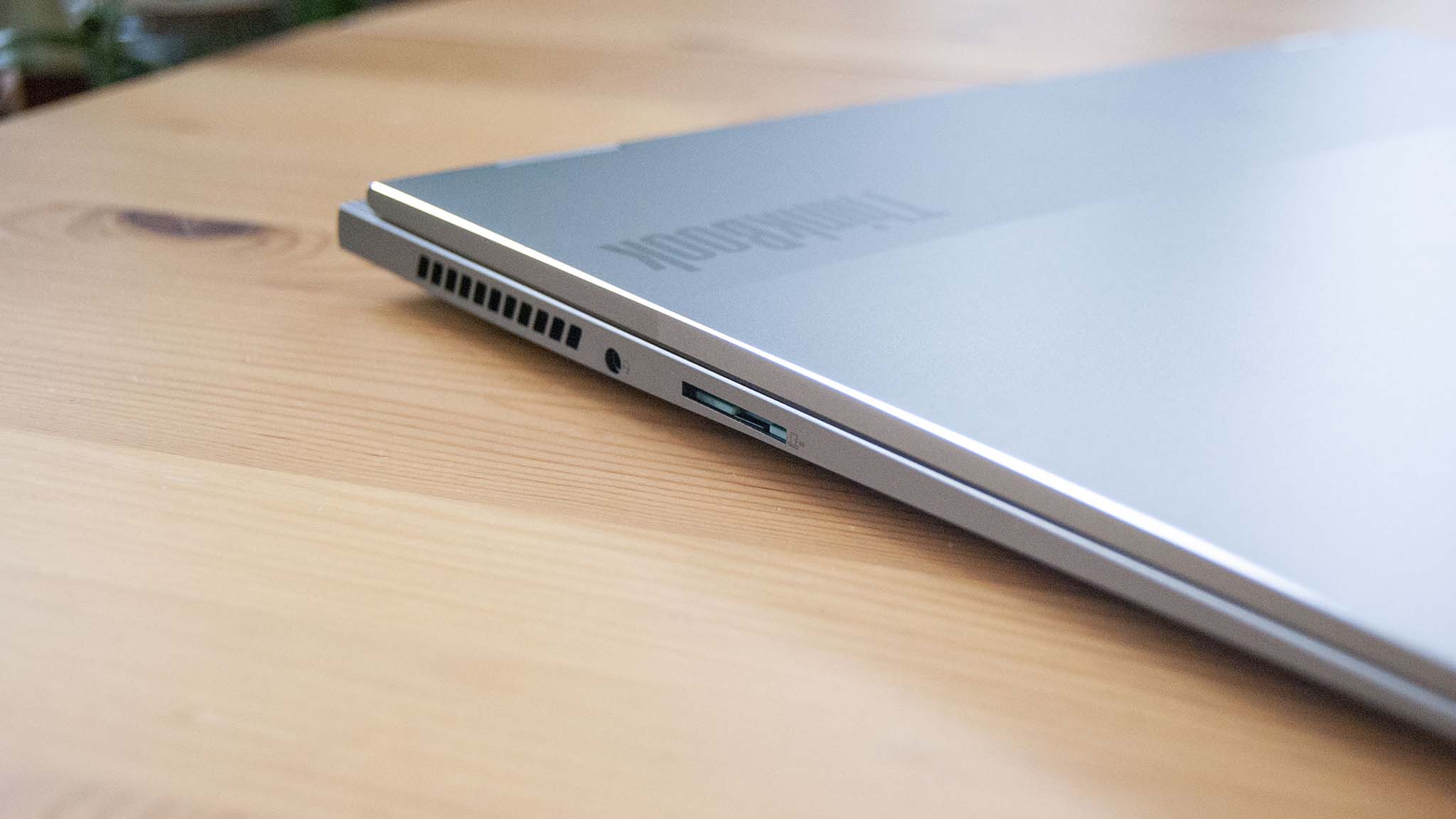
The ThinkBook 16p (Gen 3)'s design seems to be inspired in part by Lenovo's Legion gaming laptops. The lid and hinges sit forward on the bottom portion of the chassis, which results in a small "ledge" along the back. This is home to dual exhaust vents, the AC power input, HDMI port, and dual USB-A ports, keeping these more permanent cables out of the way for a cleaner look on your desk. Unlike Legion laptops, there's no plastic accenting around the exhaust and the entire chassis is much thinner.
The laptop measures just 0.64 inches (16.3mm) at its thinnest point and weighs in at 4.39 pounds (1.99kg). The wedge shape helps it look thinner than it really is, and overall it's quite sleek even when sitting closed. The sandblasted finish has a Mineral Grey color scheme that goes two-tone on the lid. It hardly picks up fingerprints and should withstand the abuse of daily use.
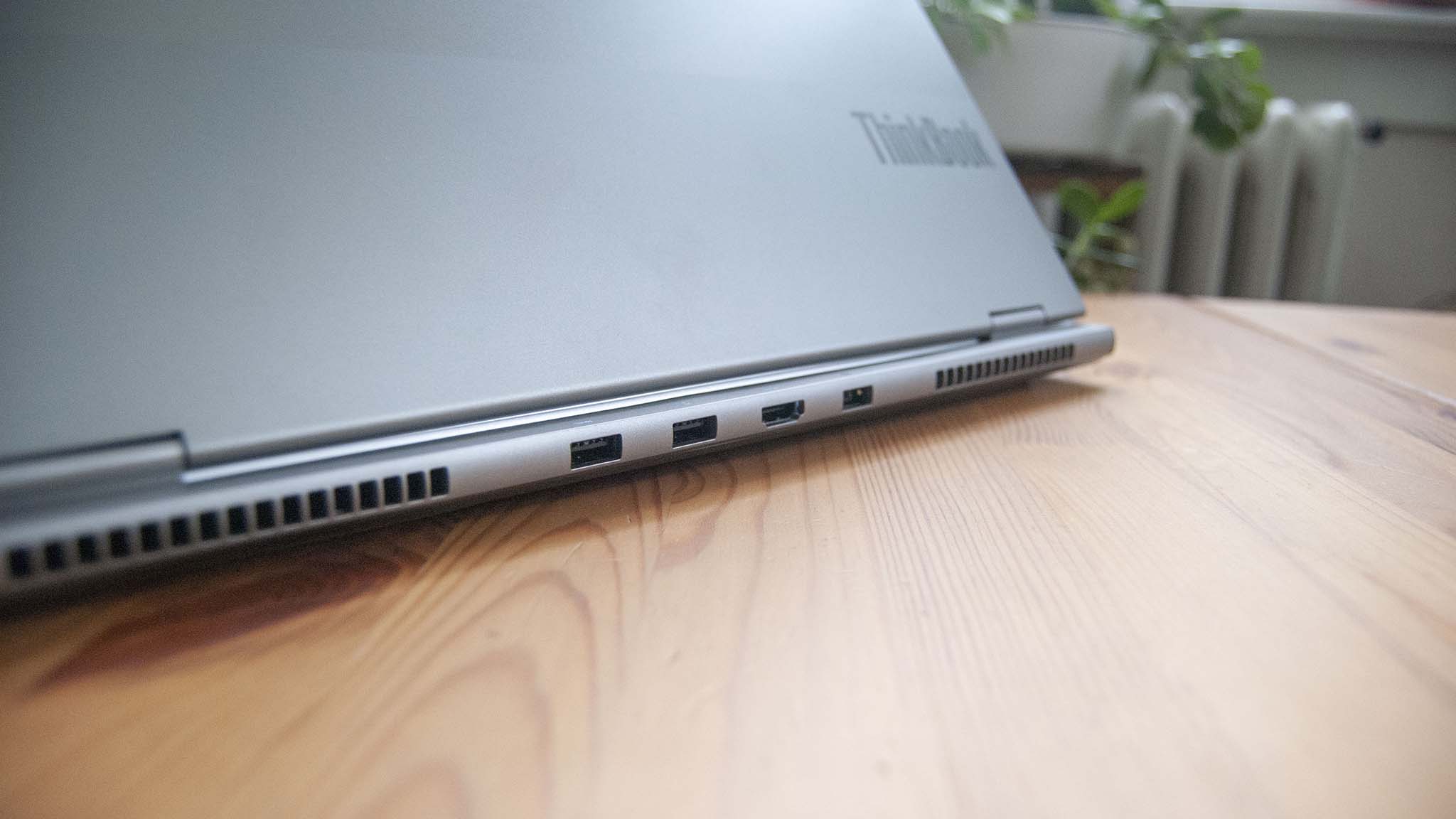
There's a massive air intake that spans the width of the bottom panel, and two more exhaust vents live on either edge alongside the rest of the ports. The right side has one USB-C 3.2 (Gen 2) and a USB4, while the left side includes an SD card reader and 3.5mm audio jack. You can use the USB4 port to connect to some of the best laptop docking stations out there, though the native port selection is quite generous. Lenovo also added a Kensington Nano lock slot for those who want to secure their PC in public areas.
Other security features include a fingerprint reader built into the power button, an IR camera for facial recognition through Windows Hello, and a privacy shutter for the webcam.
Dual 2W speakers are installed on the bottom of the laptop and come with Dolby Atmos tuning capabilities. This certainly boosts the quality of sound the laptop can produce, and there's quite a bit of volume available to work with. It would be nice to have speakers on the top of the chassis, though the full keyboard with number pad takes up too much space.
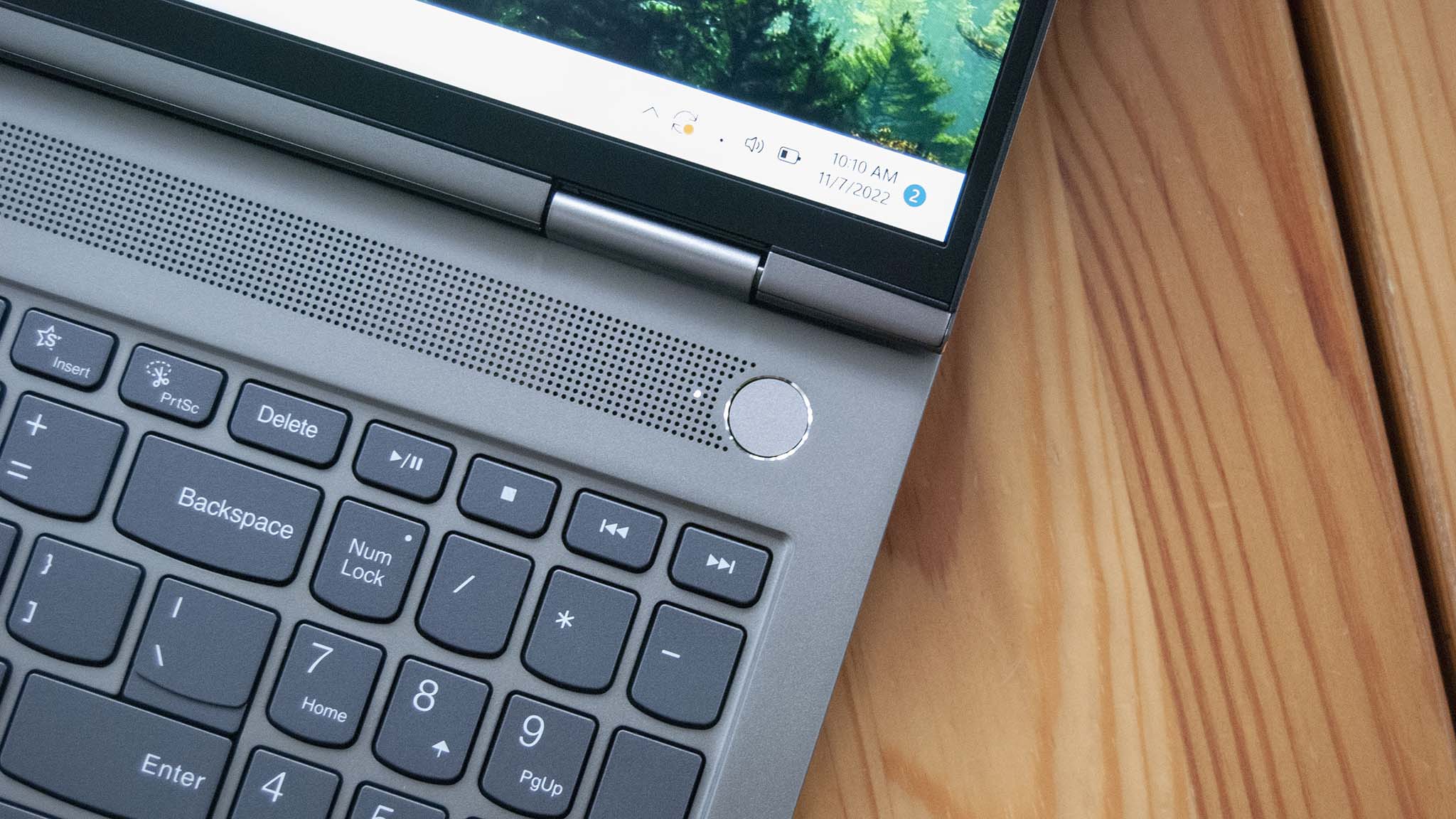
Typing is excellent. In usual Lenovo fashion, the keys have just a bit of a curve to them to better seat your fingertips. I was able to type quickly and with precision, and the backlight helped handle after hours work. The top Function row of keys includes dedicated comms keys for dealing with calls, as well as media controls above the included number pad. Despite all the space, some nav keys (including PgUp, PgDn, Home, and End) are tied into the arrow keys and require an extra Fn key press.
The ThinkBook 16p (Gen 3)'s QHD+ display is one of its best features, boasting a 165Hz refresh rate and Dolby Vision support.
Moving up to the display, you're greeted by one of the laptop's best features. The 16-inch screen dominates your view thanks to thin bezel and almost no bottom chin, and it's clear as soon as you start using the laptop that Lenovo didn't cut any corners here. My review unit has the upgraded display option, though the difference between the "base" display isn't huge.
Both screens have a 2560x1600 (QHD+) resolution, IPS panel with smart sense for automatic brightness adjustment, anti-glare finish, 16:10 aspect ratio, X-Rite Pantone factory color calibration, and Dolby Vision for supported content. The main differences are a bump up to a 165Hz refresh rate (compared to 60Hz), HDR 400 support, and an extra 100 nits brightness to hit 500 nits total. That extra refresh rate makes Windows feel extremely smooth, though it does subtract from battery life.
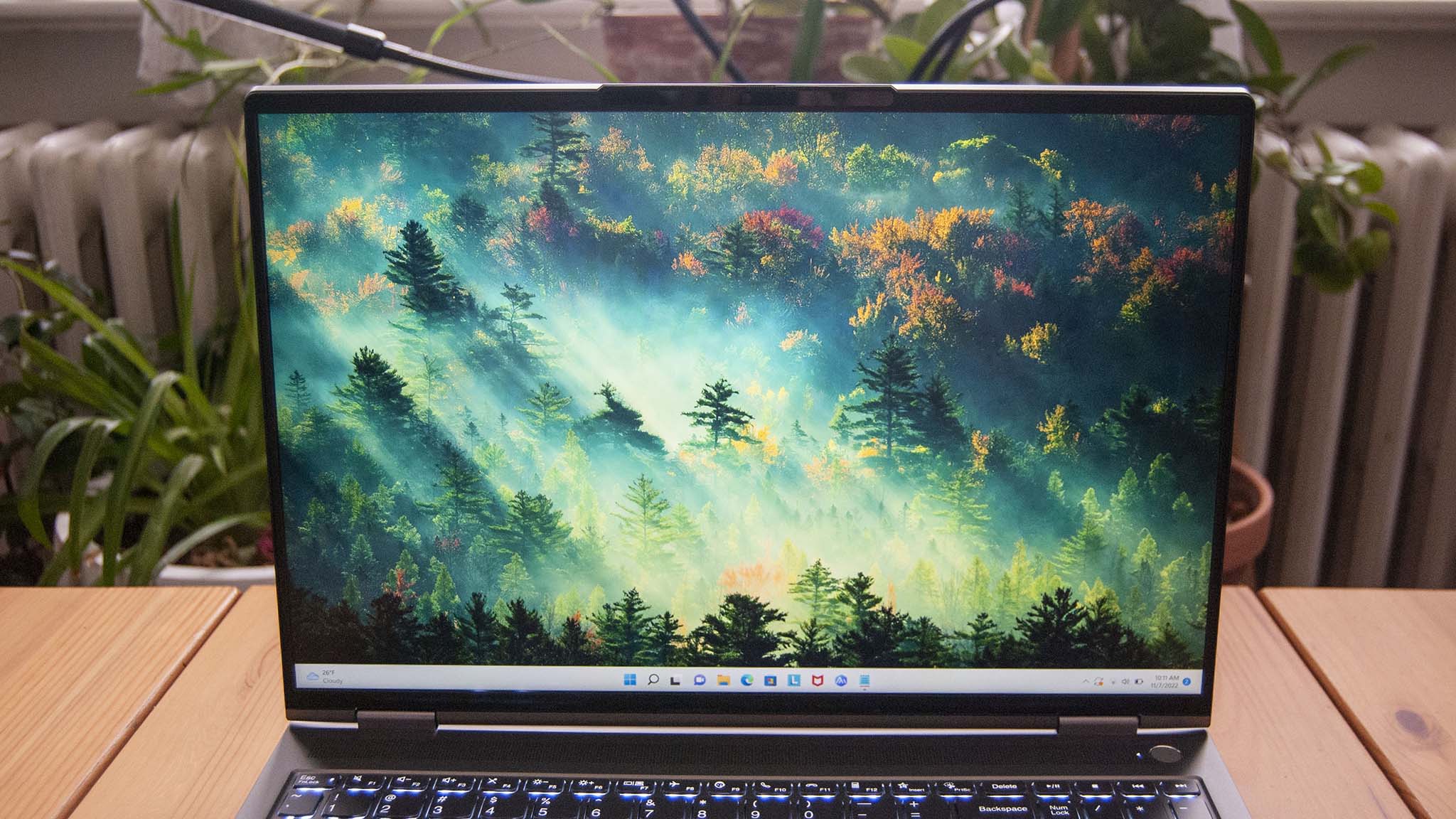
Testing with a SpyderX Pro colorimeter, I saw 99% sRGB, 77% AdobeRGB, and 79% DCI-P3 color reproduction, as well as 396 nits brightness at peak. The AdobeRGB and DCI-P3 numbers could be better, but at least sRGB is on point.
If you don't need the extra refresh rate, brightness, or HDR support, the more basic screen will save you some money and still look almost the same. No complaints here, and the displays should suit those who need something for creative and design work.
Lenovo ThinkBook 16p (Gen 3): Performance
Lenovo chose to use AMD's Ryzen 6000 CPUs in its ThinkBook 16p (Gen 3), no doubt hoping to stretch battery life for those on the move. As you'll see in the benchmark comparison graphs below, the Ryzen 9 6900HX doesn't always measure up to Intel's 12th Gen chips, even when looking at various Core i7 results.
The Ryzen 9 6900HX comes in well behind Intel in Geekbench 5, and the same is true for Cinebench R23, though to a lesser extent. These are processor-heavy tests. Measuring overall system performance via PCMark 10, the ThinkBook 16p (Gen 3) fares much better, no doubt thanks to the blazing fast SSD speed and speedy LPDDR5-6400MHz RAM.
These tests were performed using an AC adapter with Windows 11 set to the Best Performance profile. Testing battery life under these same conditions (and with the screen set to 165Hz), the laptop ran for six hours and 28 minutes in PCMark 10's Modern Office rundown test. Dropping the Windows 11 power profile down to Balanced and the screen down to a 60Hz refresh rate results in eight hours and 19 minutes of battery life.
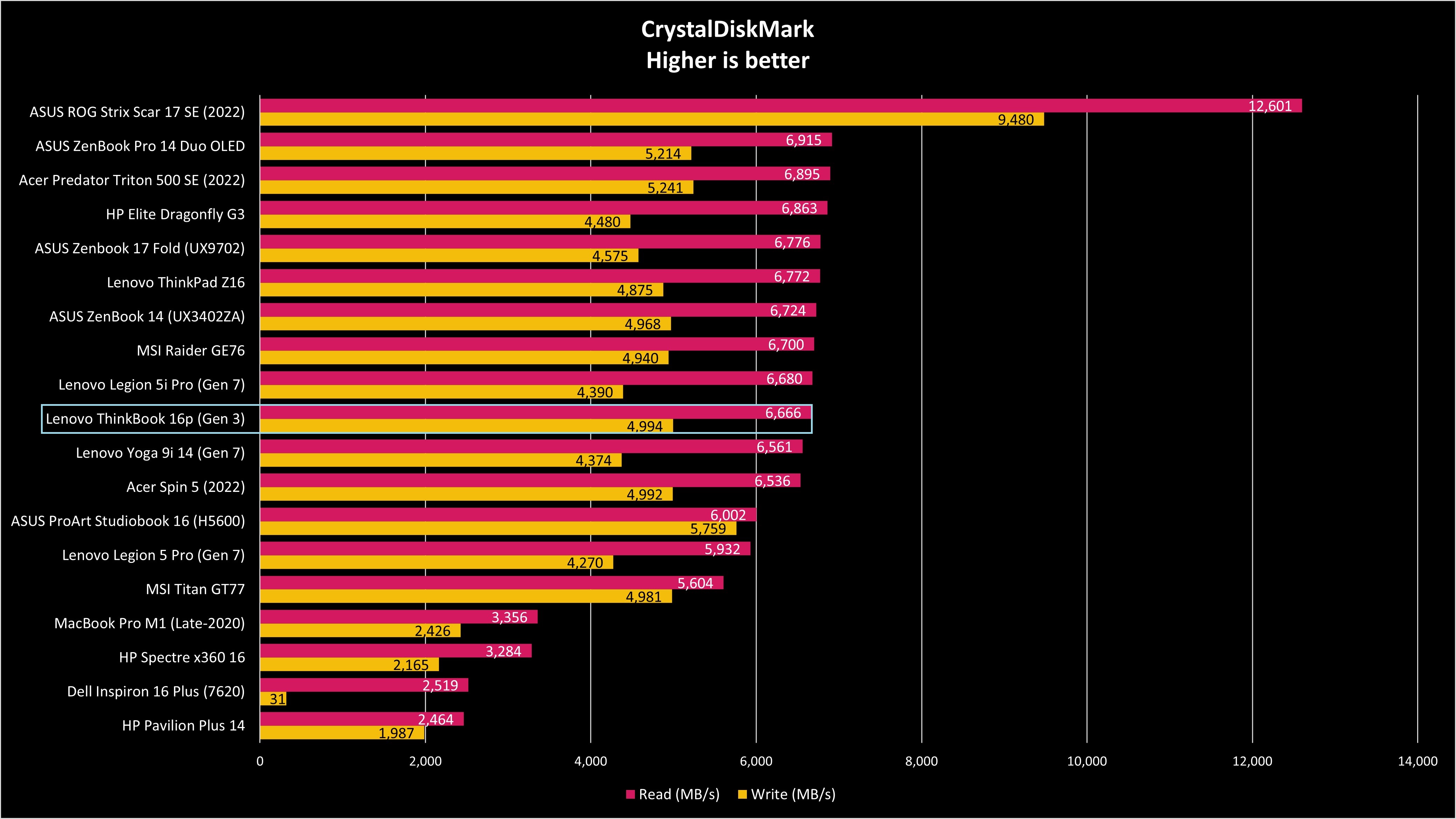
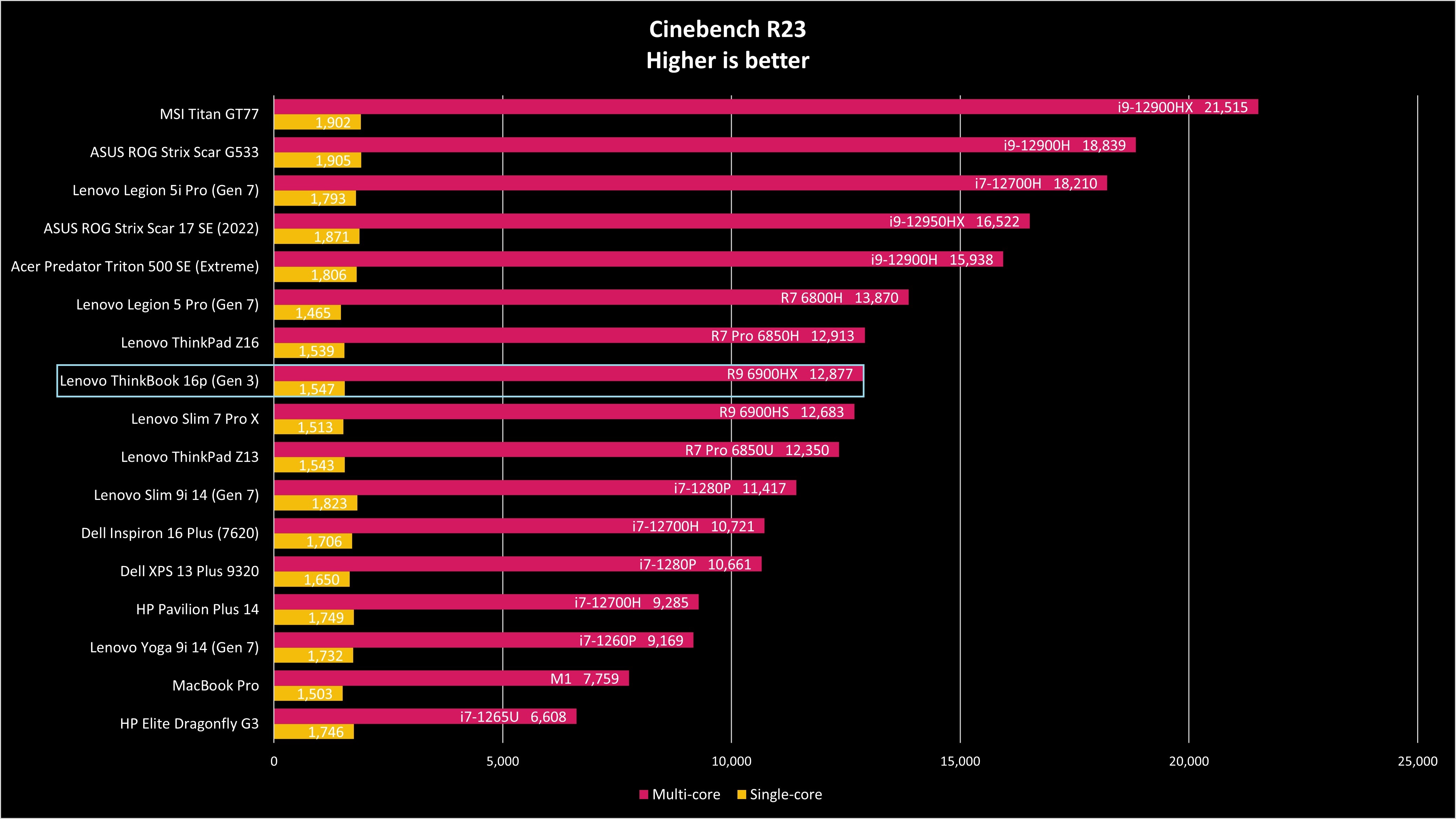
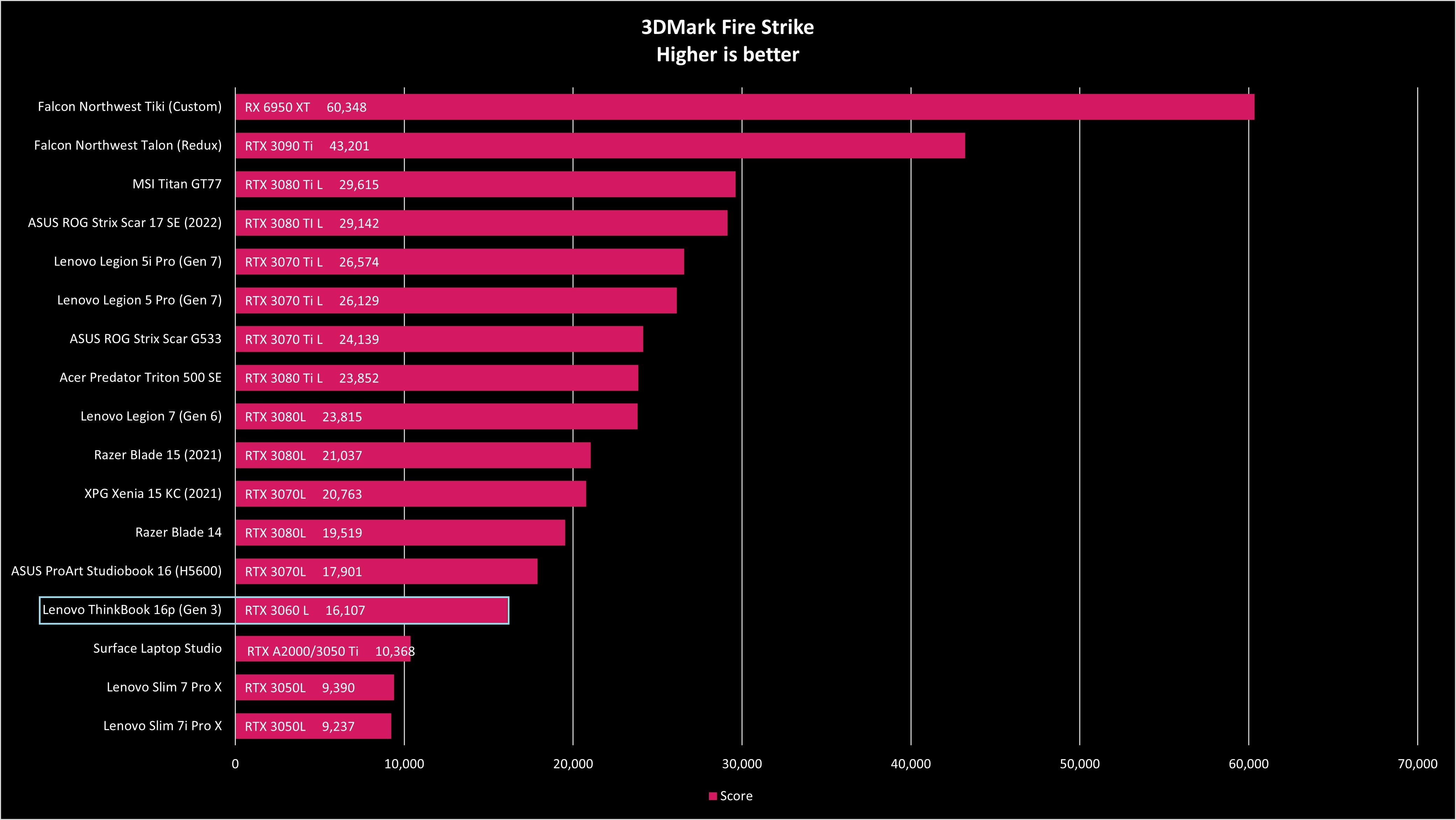
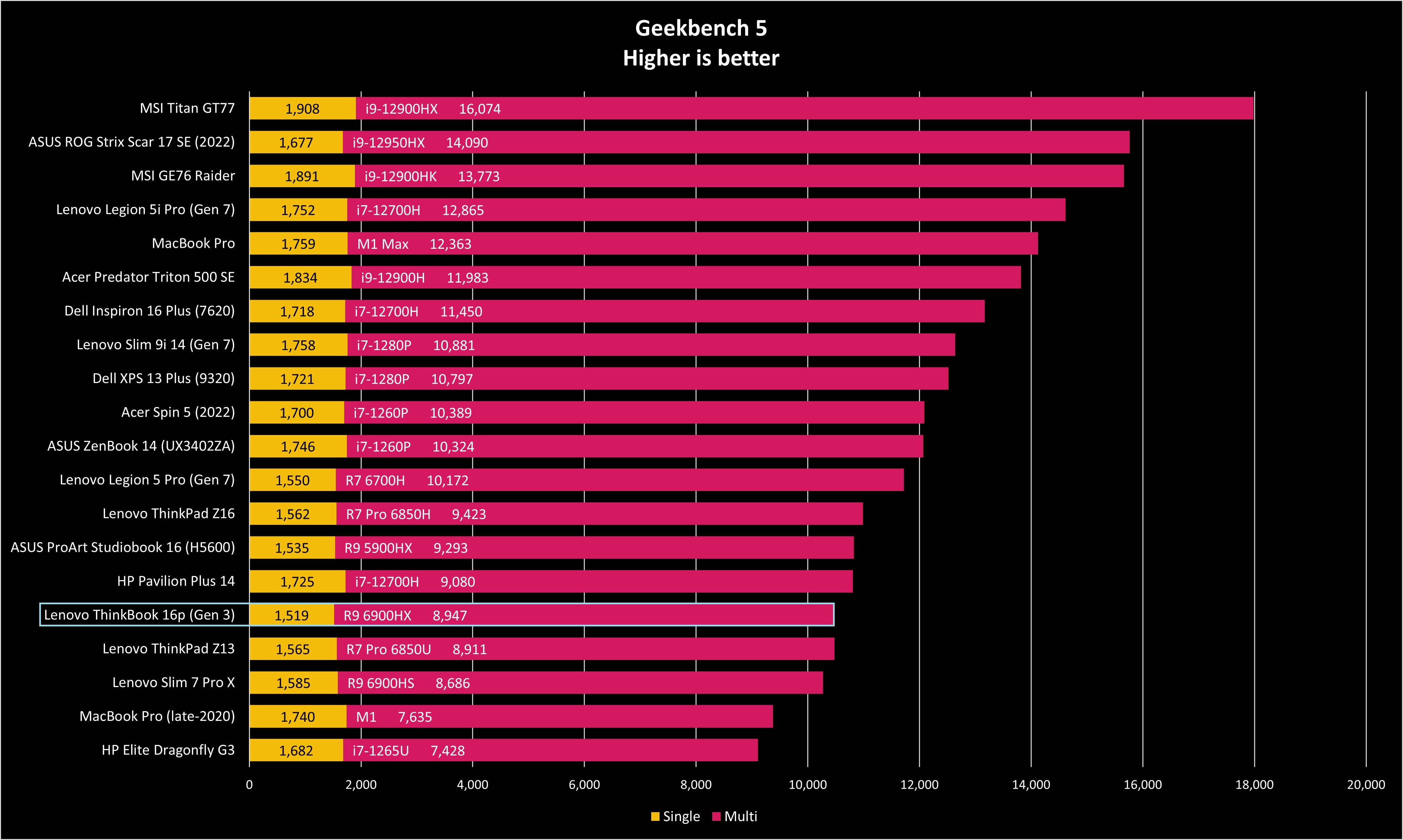
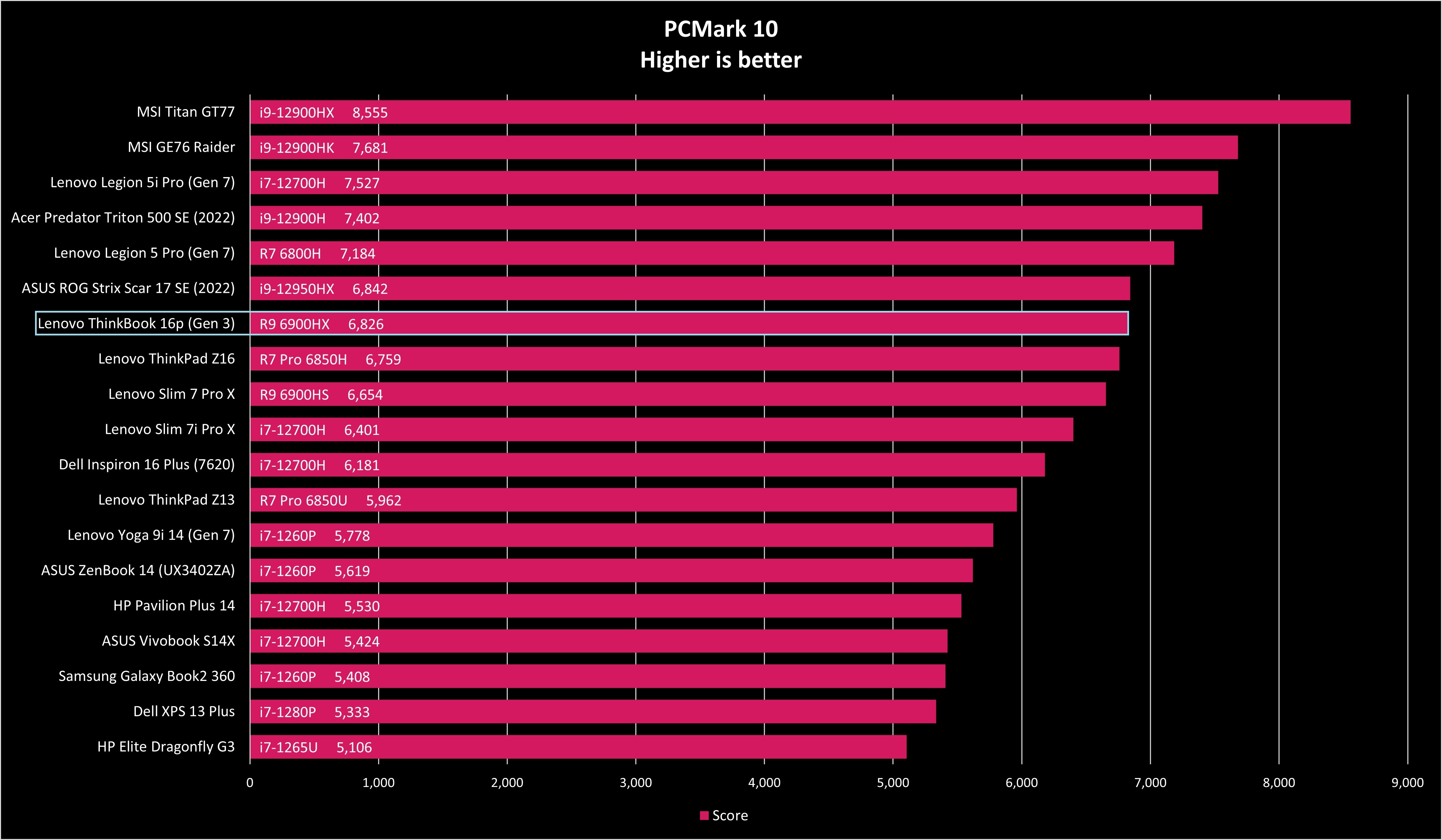
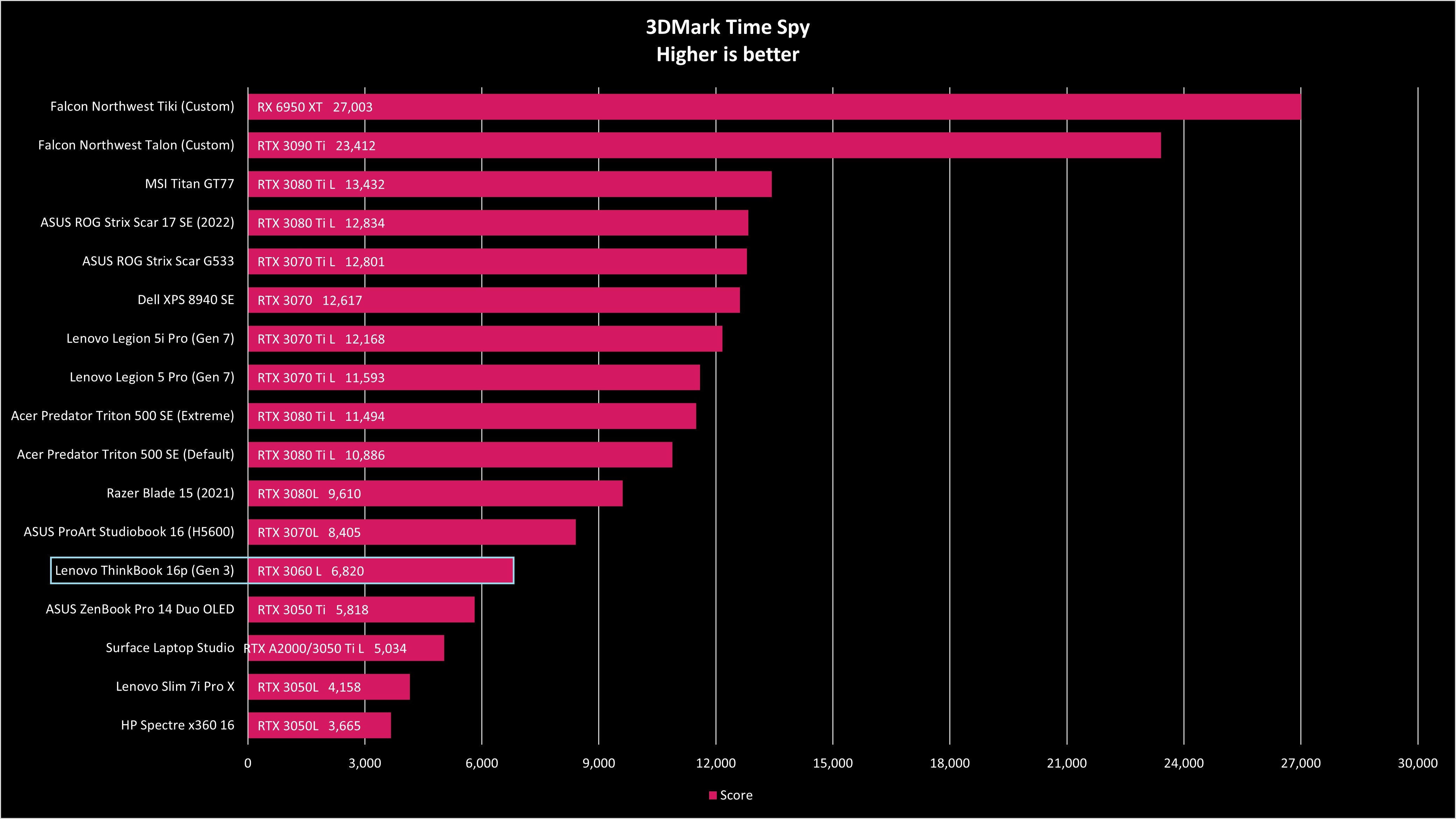
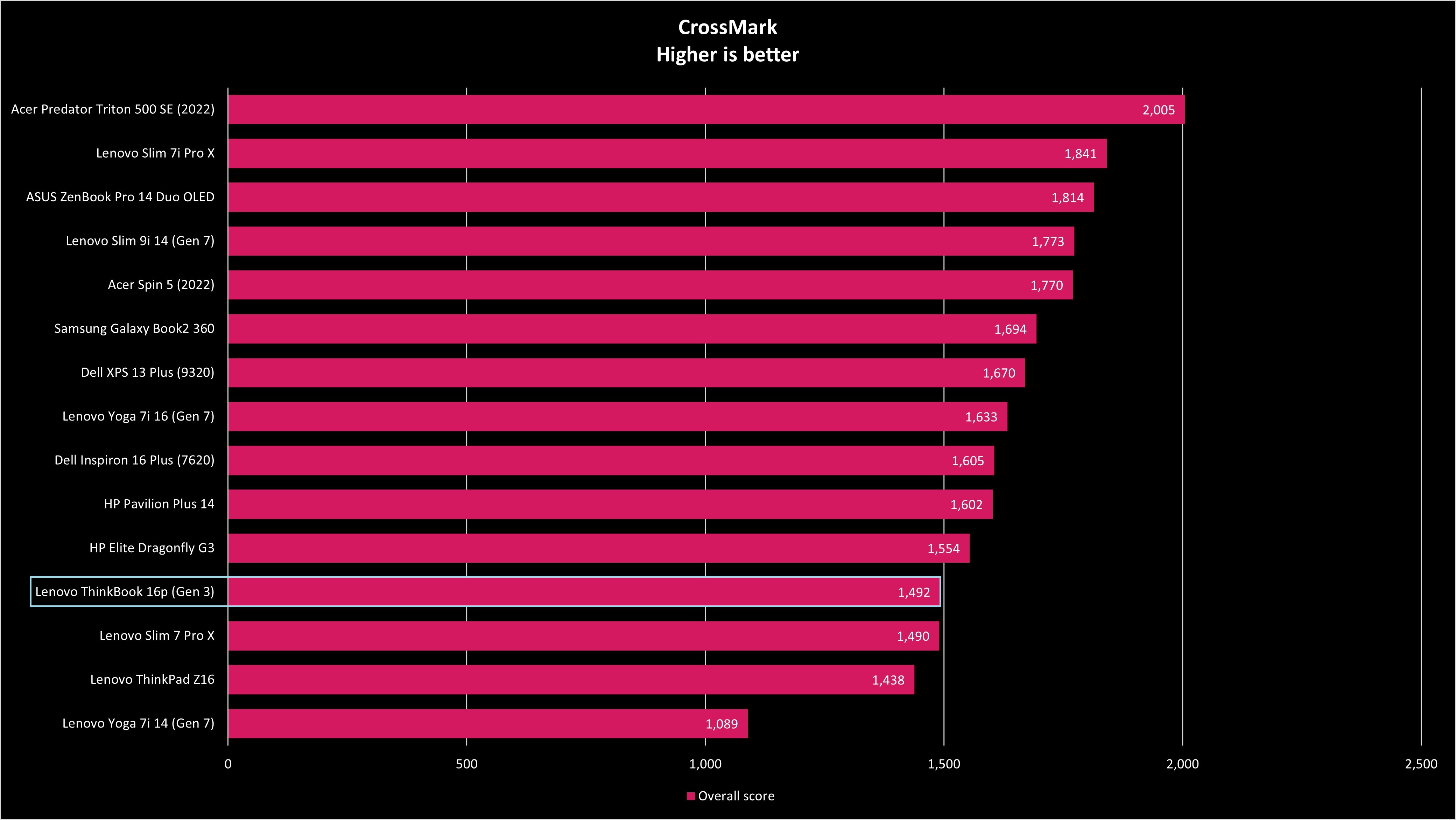
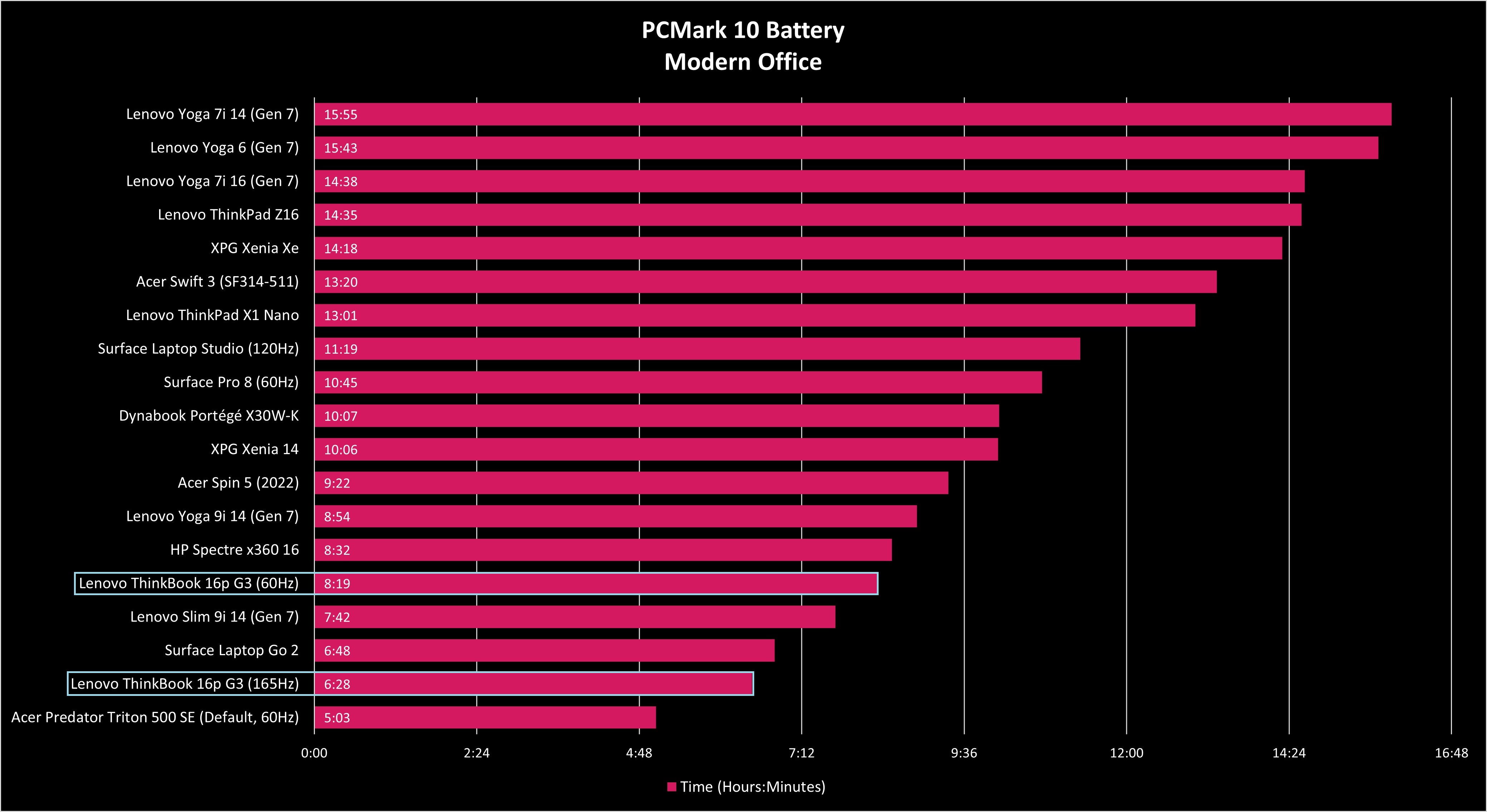
What happens when we move to battery power? SSD speeds take a huge hit, dropping by about half on the read side and by about 1,600MB/s on the write side. The PCMark 10 test drops down to a 4,937 result compared to 6,826, no doubt affected by the reduced SSD score. And the Cinebench R23 results stay pretty much the same, with about 300 less score on the single-core side. Geekbench 5 is in the same boat, dropping off slightly for single-core (1,392 compared to 1,519) and more drastically for multi-core (7,223 compared to 8,947).
The laptop feels the same when going about productivity work whether you're on AC or battery power, which is a good sign. AMD performance used to have a much larger gap when comparing the two, but it seems like it's tightened things up with the Ryzen 6000 chips. At least aside from SSD speed. If you're engaging the discrete GPU for gaming or creative work, you will want to keep the laptop plugged in.
Lenovo ThinkBook 16p (Gen 3): What I don't like
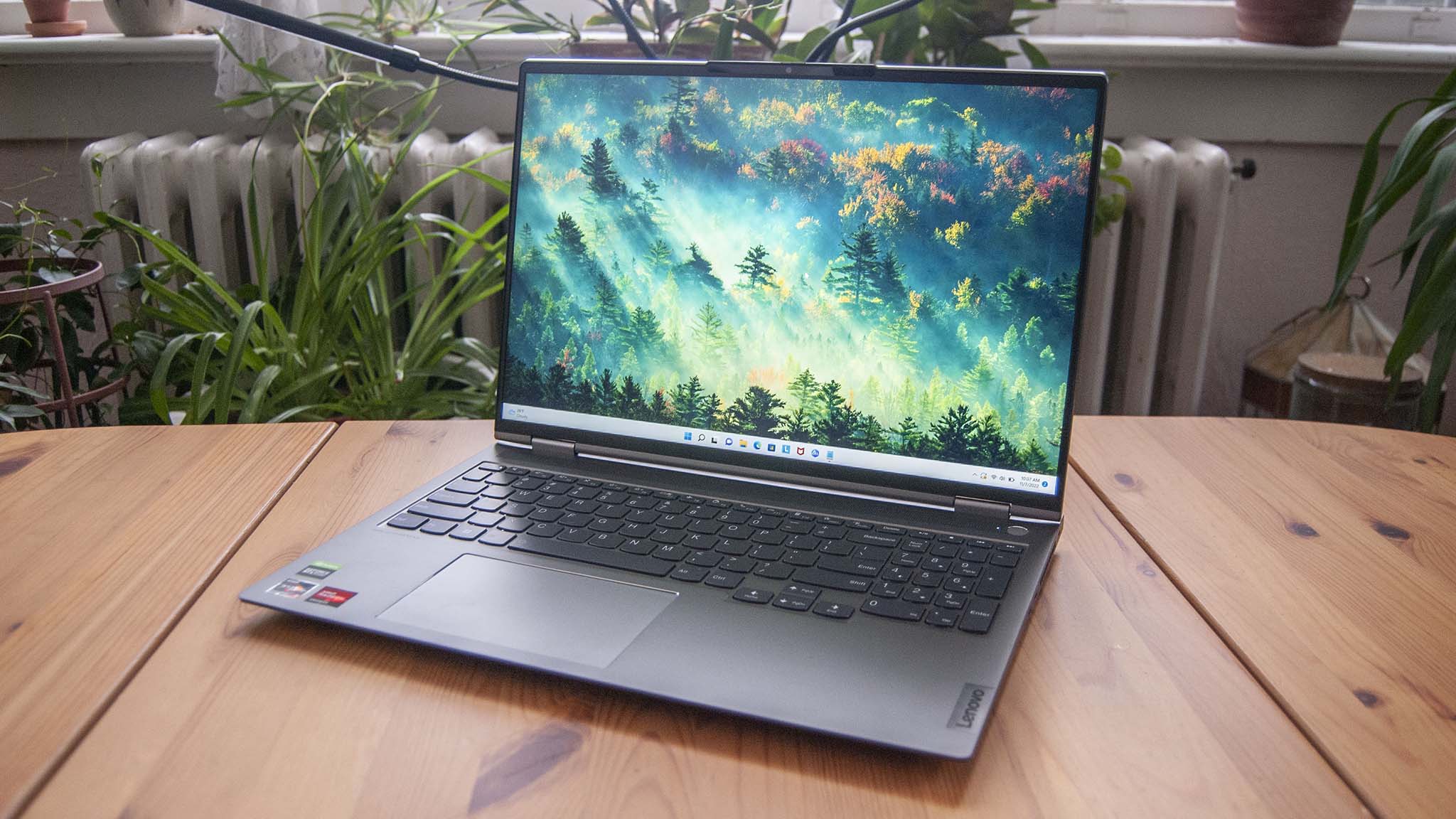
The ThinkBook 16p (Gen 3) includes seven total ports to help with connecting accessories and external displays, but its AMD platform means it lacks Thunderbolt 4. At least USB4 is available for one of the USB-C ports, which does a decent job keeping up with the Intel standard. If you are looking for true Thunderbolt 4, you'll want to check out an Intel-based system (AMD systems with TB4 are very rare).
The touchpad here is quite large and tracks well. My complaints involve the off-center positioning that leaves hardly any space for your palm on the left side, as well as the slightly hollow feel of the click on the pad itself. These are both things I can get used to, and you might have to do the same depending on the type of laptop from which you're upgrading.
I applaud the bump up to 1080p for the built-in webcam, as well as the built-in privacy shutter. The camera quality, however, is still a bit washed out. It's not going to cause issues while video conferencing, but I have seen better FHD cameras elsewhere.
Lenovo ThinkBook 16p (Gen 3): Competition
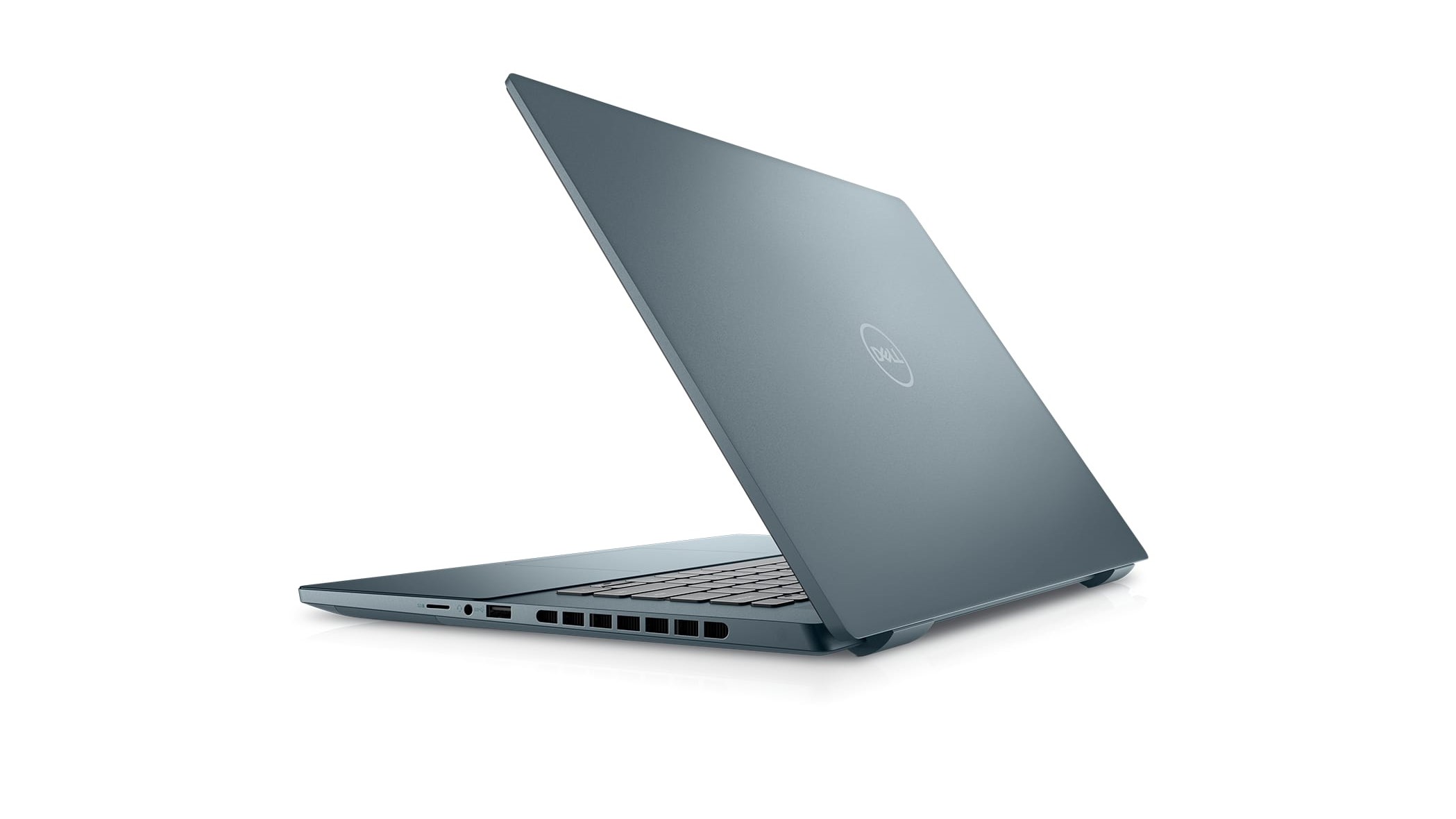
Dell's Inspiron 16 Plus is a direct competitor to Lenovo's ThinkBook 16p. It's equipped with a 12th Gen Intel Core i7-12700H CPU, NVIDIA RTX 3050 Ti or RTX 3060 Laptop GPU, up to 32GB of DDR5-4800MHz RAM, and up to a 1TB M.2 PCIe NVMe SSD. As mentioned, the Core i7 chip in other laptops we've tested outperformed the Ryzen 9 in the ThinkBook 16p, and otherwise performance hardware is similar.
The Inspiron's 16-inch display does have a higher resolution at 3072x1920 (3K), but it had a lower 60Hz refresh rate and just 300 nits brightness. Dolby Vision is included. There's also Thunderbolt 4, an FHD webcam, and quad speakers with Dolby Atmos installed on the top of the laptop. The Inspiron 16 Plus is readily available, with prices starting at about $1,300. That's far more affordable than what Lenovo has currently listed.
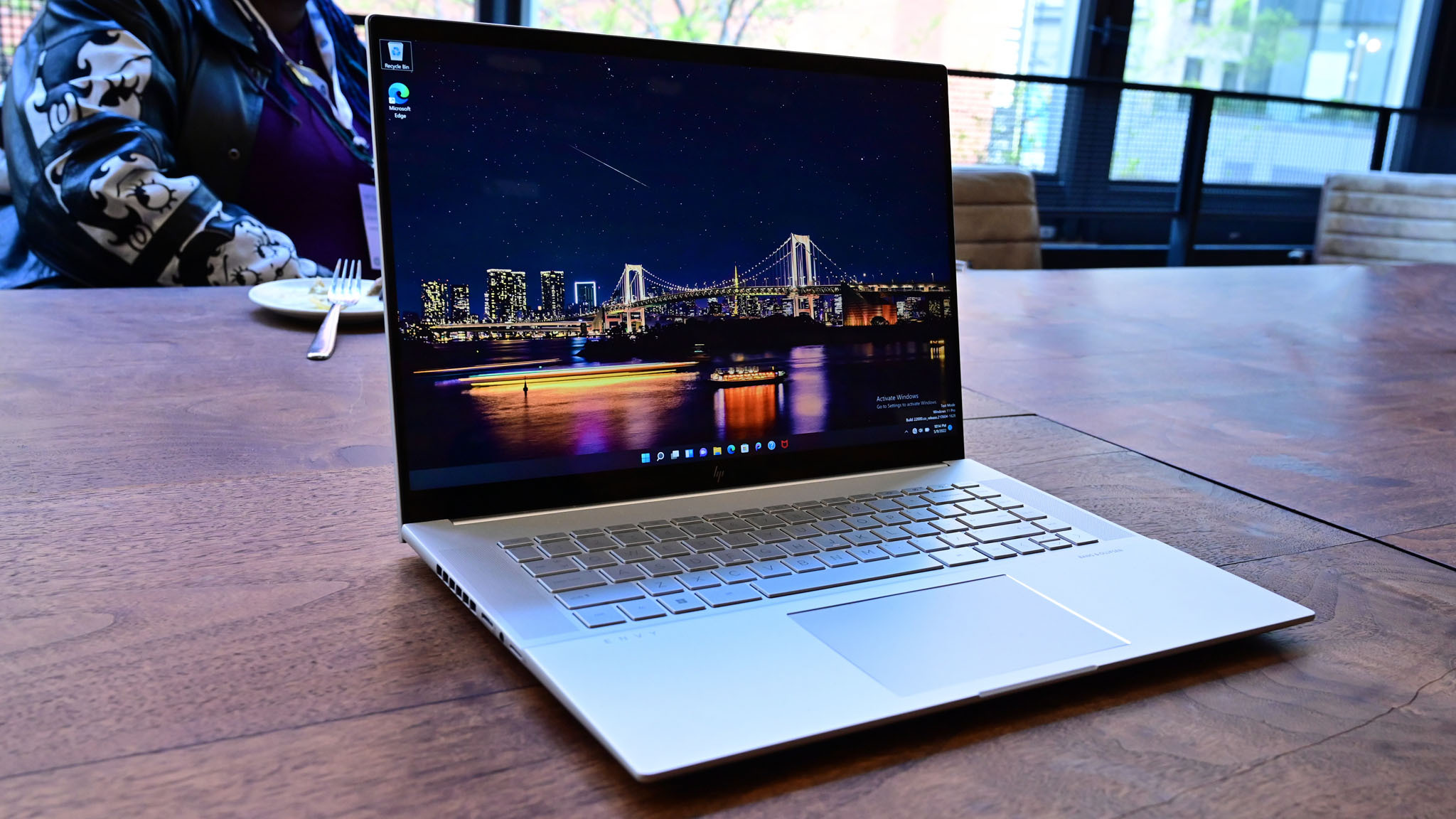
HP's Envy 16 is another great option if you're looking for a 16-inch laptop with extra performance. Models come with up to a 12th Gen Intel Core i7-12700H CPU, NVIDIA RTX 3060 Laptop GPU, 16GB of DDR5-4800MHz RAM, and a 1TB M.2 PCIe NVMe SSD.
The display has the same 2560x1600 (QHD+) resolution, and it hits a 120Hz refresh rate with 400 nits brightness and 100% sRGB color. It includes top-firing speakers, solid port selection (including Thunderbolt 4), and a beautiful overall design. These laptops start at just $1,030, making them a lot more affordable than what Lenovo is expected to offer.
Be sure to check out our collections of the overall best Windows laptops and the best Lenovo laptops if these aren't quite what you're looking for.
Should you buy the Lenovo ThinkBook 16p (Gen 3)?
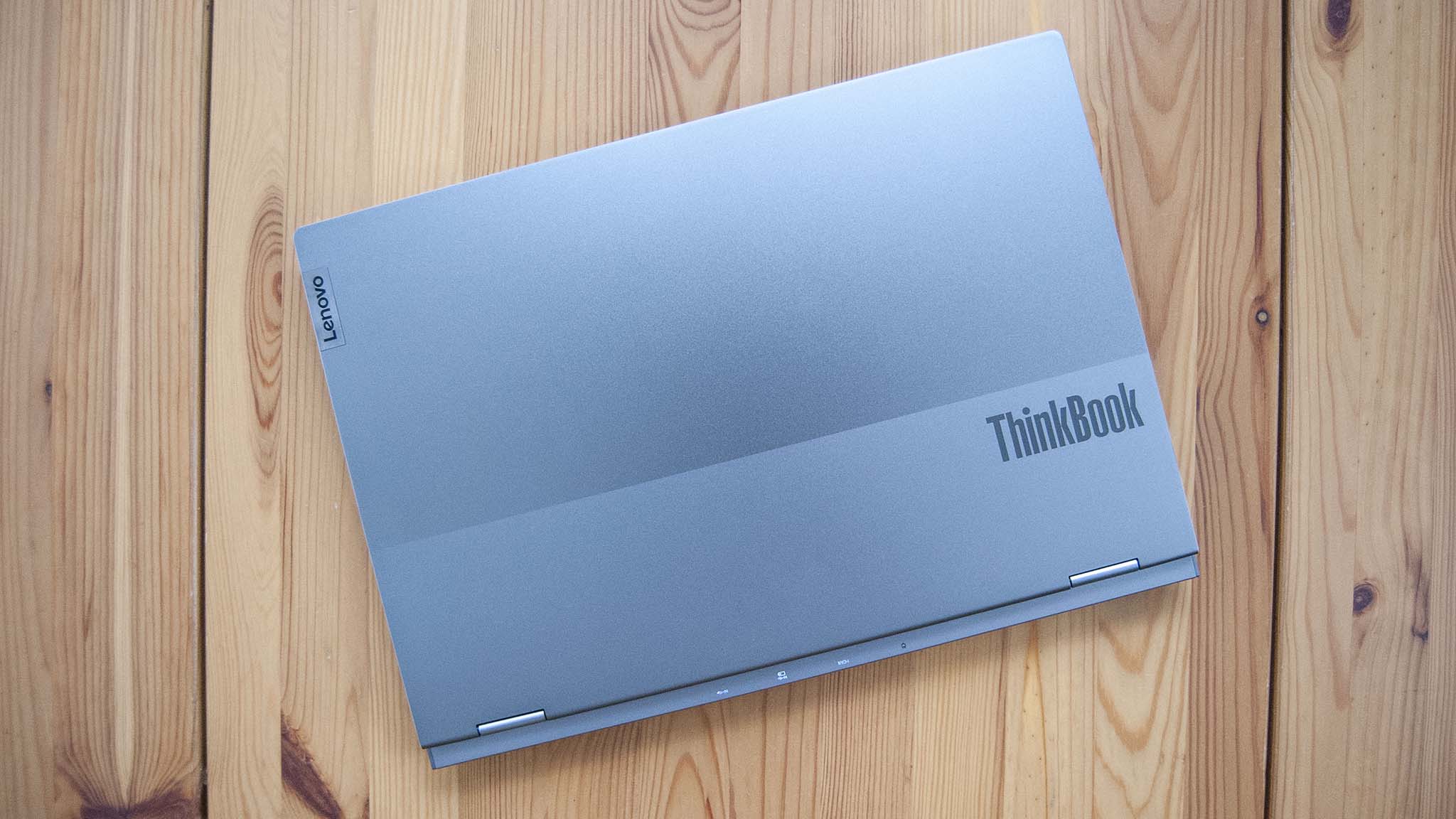
Who it's for ...
- Those who want a 16-inch laptop with QHD+ display and high refresh rate
- Those who need extra performance from discrete graphics
- Those who want a great typing experience and good audio quality
Who it isn't for ...
- Those who want a true gaming laptop
- Those who don't need discrete graphics or high-end CPU performance
- Those who want something for less than $2,000 that's available now
Lenovo's ThinkBook 16p (Gen 3) received a worthwhile upgrade for this generation, notably adding extra performance with newer hardware and a new display option. The AMD Ryzen 9 chip doesn't overperform and is bested by Intel's 12th Gen Core i7 in many benchmarks, but battery life is solid and the RTX 3060 adds the extra performance that creators need. While the display's resolution and refresh rate are impressive, the lack of accurate DCI-P3 and AdobeRGB color reproduction might miff some creators who work outside of the sRGB space.
The keyboard is superb, the audio is loud and full, and the rear port layout — tied into the overall design with display set forward on the chassis — makes using the laptop just that much easier. It's still hard to say at exactly what price Lenovo will list this laptop when it releases in more regions, but at the time of announcement it was quoted at about $2,379. That number will have to come down considerably if it wants to compete with the likes of Dell's Inspiron 16 plus and HP's Envy 16, both creator laptops available now at a much cheaper price.
Considering the ThinkBook 16p (Gen 3) doesn't really have any one standout feature, you might be tempted to not wait at all and instead jump on one of the competing laptops.
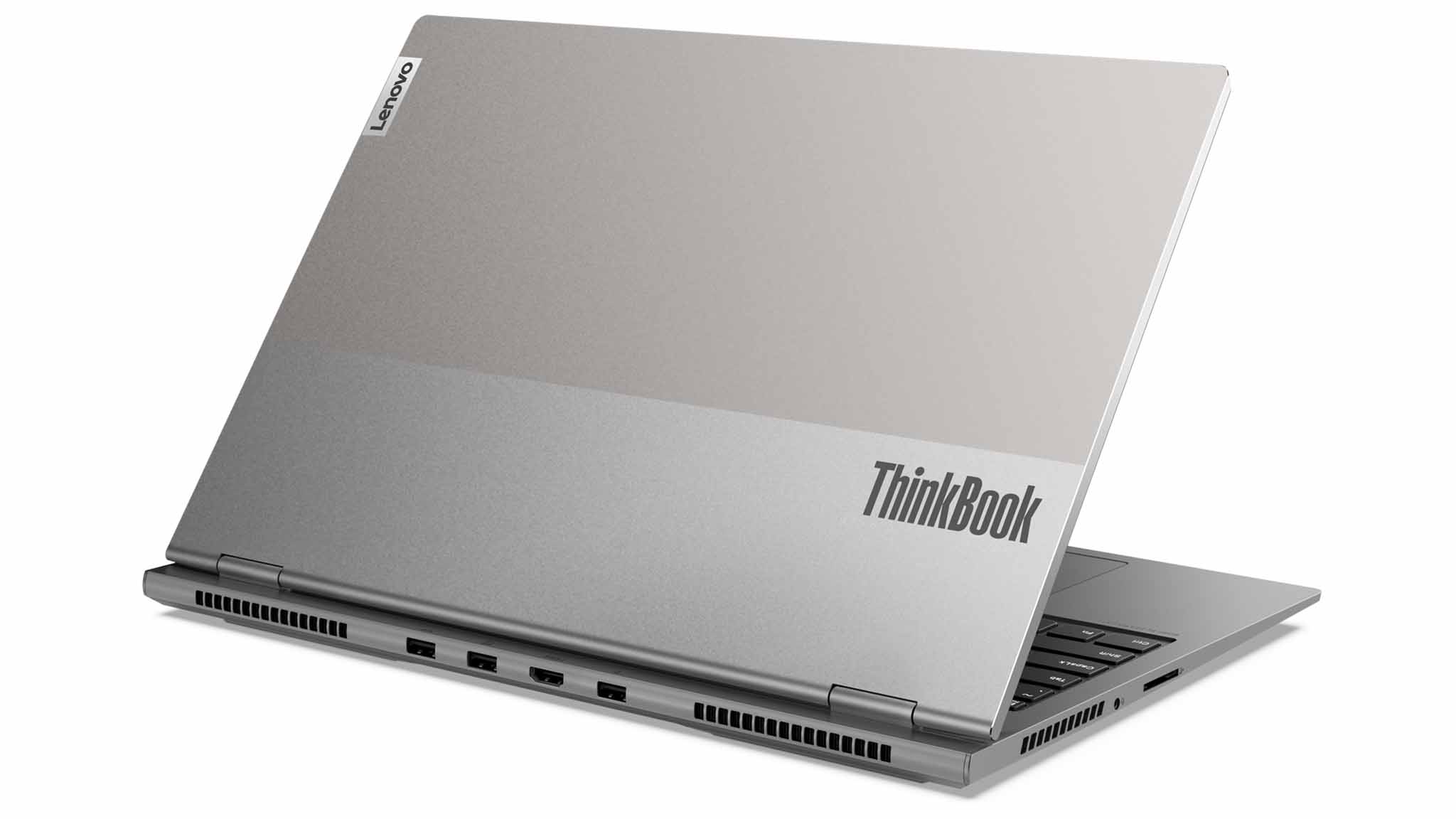
Lenovo's ThinkBook 16p (Gen 3) gets a hardware upgrade and a new display option, but it's not yet available in all regions. Considering how affordable (and impressive) the direct competition is looking these days, you might be tempted to turn elsewhere for your next creator laptop.

Cale Hunt brings to Windows Central more than eight years of experience writing about laptops, PCs, accessories, games, and beyond. If it runs Windows or in some way complements the hardware, there’s a good chance he knows about it, has written about it, or is already busy testing it.
